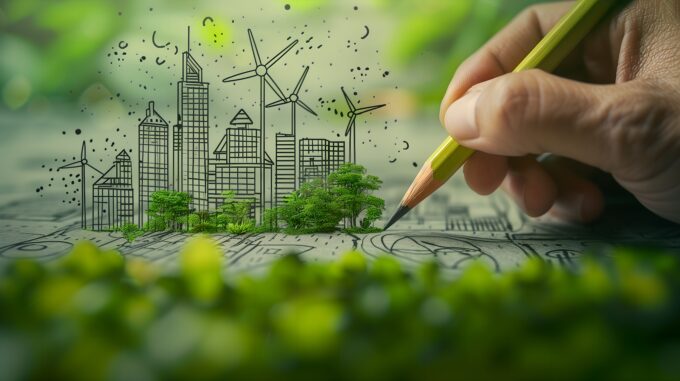
How to win over DE&I doubters and disruptors
Effective DE&I strategies are proven to enhance performance, yet they still face resistance – perhaps now more than ever. Here’s how to convince the naysayers....
Audio available

by Natalia Olynec Published December 27, 2024 in 2025 Trends • 15 min read
As the global sustainability landscape evolves, 2025 is emerging as a pivotal year for businesses grappling with new challenges and opportunities. Events such as the UN Biodiversity Conference (COP16) in Cali and UN Climate Change Conference (COP29) in Baku have underscored the urgency of transformative action, while shifting political tides including the recent US election hint at potential changes in global climate leadership. Against this backdrop, organizations must adapt to changing expectations and anticipate emerging trends that will define the future of sustainable business.
Regulatory shifts are set to redefine corporate responsibility, with mandates for science-based transition plans and detailed mandatory accountability frameworks raising the bar. At the same time, the scaling of impactful sustainability initiatives – from circular business models to biodiversity-positive strategies – signals a shift from experimentation to execution, positioning leaders to capitalize on emerging opportunities.
Collaboration across industries, governments, and civil society will be paramount in addressing the multifaceted challenges. Innovative partnerships demonstrate the need for synchronized efforts to tackle the intertwined challenges such as climate change, biodiversity loss, desertification, supply chain disruptions, and forced migration. The global nature of these transformations requires solutions that transcend regional and sectoral boundaries.
Simultaneously, the focus on leadership and talent is expanding, reflecting the recognition that personal and organizational growth are deeply interconnected. Companies are fostering skills rooted in inner development to enable systemic change while addressing the growing demand for green talent across sectors.
For management teams and boards, navigating these sustainability trends is the key to future readiness. Sustainability is no longer just a competitive advantage; it is the foundation for enduring impact in an era defined by rapid change and complex challenges.
In this context, IMD experts have identified a series of sustainability trends that will drive business priorities and transformation in 2025.
The tide is turning. Each day comes with a new announcement that firms are scaling down or reneging on their sustainability commitments. Sustainability leaders can complain about it, voice their concerns about worsening climate issues, and wait for better days. Or they could think anew about the strategies they have been relying on to push the sustainability agenda. The question of how we can make our organization more sustainable was a useful question to start with, but we propose that it has become progressively a misleading one.
In our research (Challagalla & Dalsace, forthcoming 2025), we show that firms should ask a quite different question instead: “How can firms leverage sustainability to improve the performance of their products and services and/or increase their affordability?” As firms have a fiduciary responsibility vis à vis their shareholders, sustainability cannot be a goal in itself. Rather, it should be regarded as a tool to maximize customer value. Sustainability can be leveraged at the product, business model, and strategic levels. When sustainability is positioned this way, it becomes unstoppable. Firms as diverse as Schneider Electric, Atlas-Copco, and Sika in the B2B sector, or Reckitt and Nestlé in the B2C sector, are working in this direction and making progress with sustainability, as well as business.

The sustainability landscape in 2025 will be defined by a strategic pivot: companies are abandoning fragmented and isolated sustainability initiatives in favor of scaling transformative, high-impact solutions. This trend reflects a broader realization that loosely integrated sustainability efforts are insufficient to drive competitive advantage or meet global challenges. Scaling sustainability, however, remains a challenging endeavor. Many initiatives struggle to transcend pilot stages due to financial, operational, or regulatory hurdles. Yet, 2025 is set to mark a turning point. Industry leaders like Siemens and Decathlon are at the forefront, focusing on scaling circular business models that align profitability with environmental impact.
This approach signals a shift from experimentation to company-wide execution. The shift towards scalable sustainability initiatives is increasingly recognized as essential for future competitiveness. McKinsey & Company’s research highlights that leading multinational firms are adopting strategic approaches to embed sustainability across their entire portfolios. As the first wave of global companies succeeds in scaling impactful solutions, they set a blueprint for others to follow, accelerating the transition to a sustainable economy.
Remember the times when CEOs made bold promises to reduce emissions to zero without facing any risks? Those times are over.
With the Corporate Sustainability Reporting Directive (CSRD) and the Corporate Sustainability Due Diligence Directive (CSDDD), and also under International Financial Reporting Standards (IFRS) – the S1 standard for material sustainability risks and S2 standard for climate-related risks – we are entering an era of mandatory transition plans that will be game-changers for corporate climate reporting and accountability. These plans demand detailed and science-based roadmaps over more than 20 years that connect a firm’s emission reduction intentions to long-term climate mitigation objectives formulated in the Paris Agreement. Put simply: If your company does not credibly explain how it contributes to limiting global warming to 1.5°C, you face heightened financial, market, and legal risks.
Companies of all sizes need to answer fundamental questions such as:
Transition plans are nothing less than a paradigm shift in reporting. We start in 2024 with emissions, but it is possible that we may require transition plans for zero freshwater usage, zero waste, and zero plastic usage in the future.
Despite political divides and cost concerns fueling a backlash against environmental, social, and governance (ESG) initiatives, businesses continue to progress on sustainability. Consumer demand and climate change risks continue to drive advances in renewable energy technologies, waste reduction, and circular economy practices. Globally, ESG remains a contentious issue, particularly in the United States, where critics see it as excessive and ideologically driven. However, corporate efforts have persisted even as governments show signs of slowing.
The Corporate Sustainability Reporting Directive (CSRD) continues to evolve in the EU, though the European Commission aims to streamline reporting requirements. Meanwhile, the US may withdraw from the Paris Agreement. In contrast, China is advancing ESG disclosures under its ‘Dual Carbon’ goals, prioritizing carbon emissions reduction, energy efficiency, and governance. Despite these regional challenges, corporate commitment to sustainability remains robust. Many companies still consider sustainability essential for profitability, risk management, compliance, and market competitiveness. Businesses are responding to growing consumer and investor pressure by increasing transparency, driving innovation, and aligning with sustainability trends to enhance resilience and address emerging challenges. While some focus on rebranding to combat greenwashing concerns, others intensify their efforts to meet higher standards, underscoring the importance of sustainability in long-term corporate strategy.
By embedding ESG values into strategies, family offices harness wealth to create legacies beyond financial gains – driving change for a sustainable future.
Family offices are spearheading a transformative shift from wealth preservation to purposeful investing. Impact investments, distinct from traditional ESG, focus on measurable societal and environmental contributions, with climate change emerging as a central priority for the years ahead. The rise of next-generation leaders is further accelerating this evolution, aligning investments with family values and long-term global impact.
Key strategies include defining clear ESG objectives, integrating measurable KPIs, and leveraging flexible capital for systemic change. Dedicated investment vehicles targeting biodiversity, climate solutions, and inequality reflect this focus. Additionally, frameworks like the Global Impact Investing Network (GIIN) five dimensions of impact (What, Who, How much, Contribution, Risk) enhance impact measurement, while streamlining KPIs fosters accountability without overcomplexity.
Sustainability-aligned portfolios reveal a rising resource allocation toward impact investments. By embedding ESG values into strategies, family offices harness wealth to create legacies beyond financial gains – driving change for a sustainable future.
New approaches help businesses expand their risk assessments beyond the financial implications of climate change by evaluating interconnected risks across systems. This is important because the consequences of climate change pose not only environmental risks such as natural disasters but also social risks such as threats to food and water security, mass migration away from climate-affected areas, reinforced inequalities due to loss of livelihoods, and rising geopolitical risks.
Previously, companies rarely considered such complexities, but tools are being developed to help them future-proof their operations. KPMG, in collaboration with the World Business Council for Sustainable Development (WBCSD), has developed a dynamic risk assessment to capture the complex nature of sustainability risks. The tool was piloted with 12 WBCSD member companies in the food and agriculture sector and revealed cluster risks, for example, geopolitical concerns that center around food inequality, geopolitical instability, and uneconomical farming practices.
Our research outlines four ways to consider risks more holistically – accounting for more distant stakeholders, past injustices, and current observed and overlooked risks.
Climate change cannot be solved without addressing biodiversity, which plays a critical role in mitigation and adaptation. When the United Nations Conventions on climate change, biodiversity, and desertification were agreed in 1992, they created three separate tracks for international negotiations: the Conference of the Parties (COPs). As the interlinkages between these issues become increasingly clear, there is an increased effort to better coordinate these three agendas. COPs have begun a process known as the Rio Trio Initiative, which aims for stronger partnerships and processes for these key environmental agendas.
With the United Nations Climate Change Conference (COP30) in Brazil in 2025, we can expect biodiversity to take center stage, especially given the host country’s historical role in the 1992 Earth Summit and its status as home to 60% of the Amazon rainforest. Companies will need to broaden their understanding of biodiversity and its links to climate change to stay ahead of the curve on the environmental agenda. This includes shifting from net-zero carbon targets and strategies to nature-positive ones and setting science-based targets for nature (150 companies are already working with the SBTN). You can read more here about how your company can integrate biodiversity into its sustainability strategy.
Purpose-driven work will attract and retain top performers, especially among younger, environmentally conscious professionals.
There has never been a better time to pursue a career in sustainability. Particularly in Europe, changing regulations and the energy transition are driving competition for talent. Demand for employees with ‘green’ skills in Europe rose by an average of 5% annually from 2021 to 2024, according to LinkedIn’s Green Skills report. Leading the way with the highest demand are the UK (13%), Ireland (12.4%), Norway (11.6%), and Switzerland (11.5%). Globally, Portugal (+71.3%), the United Kingdom (+46%), Costa Rica (+40%), and Singapore (+27.1%) saw the most intense growth rates from 2023 to 2024.
Supply will continue to lag behind demand, with a gap of 18.7% by 2030. The green talent pool must at least double by 2050 to keep pace, driving a surge in training. Switzerland (21.8%), Austria (21.4%), Finland (20.7%), and Germany (20.7%) have the highest concentration of green talent. These roles can be found not only in sustainability departments, but in more traditional functions such as finance, operations, and procurement.
Green skills in demand include pollution and waste prevention, renewable energy generation, sustainable finance, environmental auditing, environmental policy, sustainable procurement, and research. Hiring in 2023 was high in the utilities sector, farming, and forestry. Traditionally polluting industries, such as oil, gas, and mining are particularly hungry for talent to lead the transition and engage investors.
In 2025, talent development and sustainability will converge as key priorities for organizations to address global challenges. Companies recognize the need to align employee growth with sustainability goals and increasingly incorporate the Inner Development Goals (IDGs) into developmental work to drive outer change. Fostering IDG skills in the five dimensions of being, thinking, relating, collaborating, and enabling change is recognized as essential for individuals and organizations to lead systemic change. This trend moves talent development and sustainability beyond technical expertise in the age of AI to emphasize human skills to navigate and lead complex systems. Furthermore, talent strategies that integrate purpose-driven work will attract and retain top performers, especially among younger, environmentally conscious professionals. For example, IKEA has integrated the IDG framework to enhance leadership capabilities essential for driving meaningful progress and transformational change.
A new breed of ‘impact secondaries’ is transforming early-stage exit dynamics in impact investing. These specialized funds, like Renewal Funds’ Secondary Impact Fund, purchase stakes in Series A and B social enterprises from early investors, providing crucial liquidity without forcing premature exits. Recent data from the GIIN shows these secondary transactions growing 85% year-over-year, with average holding periods decreasing from seven to four and a half years. Standardized impact criteria enable faster due diligence and portfolio transfers while preserving the company’s social mission. Village Capital’s early-stage portfolio demonstrates the model’s potential, achieving three partial exits through impact secondaries while maintaining their investees’ original impact targets.
This innovation matters because it solves one of impact investing’s most persistent challenges: the mismatch between patient capital needs and investor liquidity preferences. By creating a viable secondary market for early-stage impact investments, these vehicles could unlock significantly more capital for the sector. Traditional investors who previously hesitated due to long holding periods can now participate with greater confidence. For impact founders, these secondaries offer a middle path between maintaining their mission and providing returns to early backers.

“By balancing technological advances with a focus on what makes us human, businesses will accelerate sustainability transitions and cultivate a thriving workforce capable of meeting the complexities of the future with a sense of calm.”
A changing world requires an increased focus on transformational skills and employee well-being. In 2025, the shift from ‘power over’ and ‘play to dominate’ to ‘power with’ and ‘play to thrive’ reflects an evolution toward collaborative, purpose-driven organizations that empower people and foster resilience. Combining emotional security with a drive for exploration, Secure base leadership will be critical. Companies like electricity producer and energy provider ALPIQ and asset management firm ROBECO are seeing the benefits.
This approach aligns with the IDG’s work in the five areas of being, thinking, relating, collaborating, and acting which is necessary to make any real progress towards the 17 Sustainable Development Goals (SDGs). Embedding well-being into everyday practices will be essential, as our increasingly uncertain world places stress on all employees. Companies will need to balance work demands with initiatives that normalize stress management, mindfulness, breathwork, and adaptability. By balancing technological advances with a focus on what makes us human, businesses will accelerate sustainability transitions and cultivate a thriving workforce capable of meeting the complexities of the future with a sense of calm, confidence, and creativity.
Complex societal challenges demand innovative approaches that bring together diverse capabilities and perspectives. Progress comes through purposeful coalitions of actors – corporations, government entities, social entrepreneurs, and, importantly, communities themselves – working together toward shared goals.
When large corporations like SAP partner with social entrepreneurs and local communities, they combine complementary strengths: corporations contribute scale and resources while social entrepreneurs bring agility and innovation – and, when they authentically engage communities, they provide vital local knowledge and cultural understanding. These partnerships can create solutions that are both scalable and contextually appropriate.
Sustainable development cannot be achieved through top-down initiatives alone. It requires creating spaces where global capabilities meet local wisdom, where institutional resources meet community knowledge, and where different actors align around a common purpose. These collaborations can generate transformative and lasting innovations.
The world has entered an era of persistent, overlapping crises, including pandemics, climate emergencies, geopolitical conflicts, declining democracy, and economic instability, which collectively challenge societal stability. In this context, social enterprises – organizations that address social problems through market-based means – are increasingly adopting a political dimension to drive positive social change. This shift emphasizes influencing public policy, legislation, and societal norms.
For example, Too Good To Go, a social venture combating food waste through a digital app that creates a marketplace for surplus food, recently led a coalition of over 30 UK food industry leaders in urging the government to mandate public food waste reporting. By advocating for policy reform, the organization demonstrates how social enterprises are leveraging political capital to tackle structural socioenvironmental challenges. This trend highlights a shift towards multi-objective organizing, where organizations pursue diverse social outcomes, including policy advocacy, to address the multifaceted nature of complex social and environmental problems. As their political role expands, social enterprises will likely become critical agents of systemic change in addressing recurring global crises.

“In 2025, two megatrends, AI and sustainability, are converging to redefine how businesses address environmental and social challenges.”
Investment in climate change adaptation is increasingly essential as physical damage from climate-related disasters increases, affecting companies’ production facilities, suppliers, and customers and creating significant financial risks. To address these challenges, businesses must actively monitor and manage climate risks. One IMD client employs analytical tools to assess natural catastrophe classifications across its global sites. This approach has shaped its strategy, guiding targeted assessments for flood, windstorm, and earthquake risks, followed by risk reduction measures.
Another client opted to sell a facility, partly due to heightened uncertainty caused by frequent droughts, which impacted river shipping and increased reliance on more costly, higher-emission truck transportation. Proactive adaptation measures not only mitigate risk but also support long-term operational resilience. As climate impacts intensify, chief risk officers and financial officers are increasingly prioritizing adaptation strategies to safeguard assets and maintain business continuity in a changing environment.
Both the speed of climate impact and the human and social reaction to it remain highly uncertain, creating a subcontext that is even more challenging. The role of non-executive board members in such a context is crucial for governance quality. Unlike executives focused on daily operations, non-executive directors (NEDs) bring a broader, long-term perspective, helping companies anchor sustainability strategically within the organization as well as navigate risks. In the words of Nestlé Chair Paul Bulcke, the role of the board is to “see the context and maintain the balance,” ensuring the organization navigates competing tensions in a manner that is well aligned with its strategy – and by implication its risk appetite.
Independent and diverse views brought by NEDs can contribute to stronger and more creative decision-making. This allows them to transcend conventional approaches and capitalize on unconventional opportunities – as well as see risks that executive board members might not have on their radar. In a context characterized by mounting uncertainty, non-executive leadership will be critical in shaping strategies and driving progress toward sustainable, long-term value creation.
In 2025, two megatrends, AI and sustainability, are converging to redefine how businesses address environmental and social challenges. AI will become indispensable for sustainability efforts, automating complex reporting, improving data quality, and unlocking actionable insights. With stricter global regulations, such as the EU’s CSRD, AI will offer the tools to streamline compliance and align sustainability with business strategies.
Yet, as AI eases our lives, its own social and environmental costs cannot be ignored. The massive energy and water demands of AI systems pose a significant risk to sustainability goals. For instance, Microsoft reported a 30% increase in emissions tied to the expansion of its AI offerings. However, it is essential to distinguish between the energy-intensive process of training AI models and the much lower emissions required to run them. Generating content with trained models can often be significantly more efficient in terms of CO2 compared to traditional methods.
Simultaneously, AI threatens to accelerate job displacement, especially in the short term and within already vulnerable sectors. A report by the World Economic Forum indicates that clerical and secretarial roles are especially susceptible to rapid decline due to AI advancements. These challenges demand bold action: companies must embrace ‘green AI’ by prioritizing energy-efficient technologies and renewable energy while fostering workforce resilience through comprehensive upskilling and reskilling programs.
In 2025, the question looms large: will technology be a friend or foe in advancing our global sustainability agenda? The answer will depend on how we manage to balance innovation with responsibility and accountability.

Chief Sustainability Officer at IMD
Natalia is the Chief Sustainability Officer at IMD. She designs and implements sustainability strategy, develops executive education programs and advisory, publishes research, builds cross-sector partnerships, and communicates IMD’s ambitions and progress. The Center for Sustainable and Inclusive Business, co-led by Olynec, aims to support leaders and companies to take steps towards a more sustainable and inclusive business world by harnessing IMD’s knowledge and expertise in this field and offering tools to help them deliver systemic, innovative, and impactful responses.

May 22, 2025 • by Josefine van Zanten, Luca Condosta in 2025 Trends
Effective DE&I strategies are proven to enhance performance, yet they still face resistance – perhaps now more than ever. Here’s how to convince the naysayers....
 Audio available
Audio available
April 22, 2025 • by D W Pine in 2025 Trends
Responsible for TIME magazine’s iconic covers, D W Pine explores his creative process and shares insights on how to cut through the noise and make an impact....

February 7, 2025 • by Carlos Cordon in 2025 Trends
President Trump will be erratic, warns IMD’s Carlos Cordon, so supply chain leaders must be prepared to work with what he gives them...

February 3, 2025 • by Natalia Olynec in 2025 Trends
Warnings about alcohol’s harms by medical experts are nothing new. But the drinks industry is now taking sobriety seriously by investing in a growing range of alternative products....
Explore first person business intelligence from top minds curated for a global executive audience